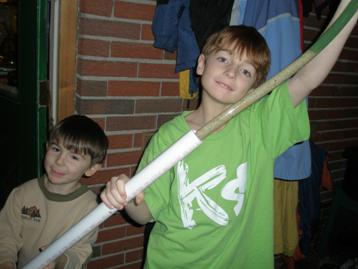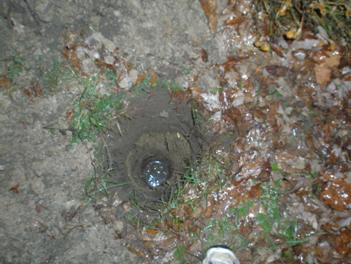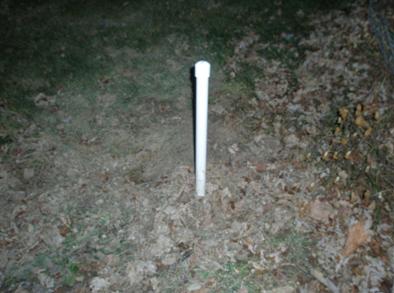3 December 2007
December certainly came in with a bang in the United States. A major winter storm moved from California to Colorado to the Great Lakes to the East Coast. It brought snow, sleet, rain, freezing rain and strong winds for a large part of the country. There was some crazy weather at my house. Saturday night it snow about 4 cm (1.5 inches). Then there was about 0.5 cm of ice that fell as freezing rain and sleet. Luckily the electricity did not go out which is a typical occurrence in an ice storm. On Sunday, the warm winds started to blow out of the south and the temperature shot up to 13° C (55.4° F). Now, it is cold with very high winds. It is expected to stay cold for the rest of the week in Toledo, Ohio.
Some of the snow totals around the United States from the storm are impressive. Parts of Minnesota, Wisconsin and Michigan received between 30 and 60 cm of snow. This storm produced half a meter of snow for the ski resorts in the Rocky Mountains. As I write this, the one storm is exiting the United States via Maine and a new storm is coming in off of the Pacific Ocean into Washington, Oregon and California. Lake effect snow around the Great Lakes is the big story tonight. Many of the schools in the snow belt areas southeast of the lakes will be getting significant snow over the next few days. Also, just to give you all a potential heads up, right now the weather forecast models are forecasting another major winter storm for next Monday and Tuesday that is forecast to take a very similar track to the one we had this weekend. We shall see what happens.
We are up to 26 schools participating in the field campaign. The more schools that participate, the more comparisons that can be made. I know there will be more students from different schools participating.
Seasons and Biomes Snow Tube
Over the weekend I got my frost tube put into the ground. You may be thinking, “What is a frost tube?” Well, it is a tube filled with water that you put into the ground. Each week we will pull it out of the ground and look to see the depth that the ground is frozen to. The frost tube is a new GLOBE protocol is part of the Seasons and Biomes Project that GLOBE is undertaking in collaboration with the University of Alaska, Fairbanks.
I had the opportunity to go to Fairbanks, Alaska twice in the last year. It was a great experience. I met people from all over the world and made a lot of good friends. I wanted to share this with you because I think it is funny. Janna, a nice teacher from Greenland, said that I was a southern boy. I have never been called a southern boy before in my life. I grew up near Buffalo, New York and usually people from Buffalo are considered northerners. I guess it all depends on your perspective. Buffalo is quite a bit south of Janna’s house in Greenland.
Kenji Yoshikawa is a research scientist who specializes in studying permafrost. He showed the meeting attendees how to make the frost tube. I think it will be very interesting to take these new observations. I bet I am the only person in my neighborhood with a frost tube. I finally got mine in the ground Sunday. The surface froze last week but melted again this weekend. I am so glad I got my frost tube in the ground because the temperatures are going to remain at or below freezing the rest of the week.
There are many things that affect the depth that the frost will occur in the ground. The main thing is the outdoor air temperature. What else could affect the depth of frost in the ground? I’m sure you can come up with lots of things.

Figure 1. My sons Robby (9) and Timmy (4) showing off our frost tube. Note that the frost tube is made up of a clear tube filled with water (and sand) inside a white PCV tube.

Figure 2. I dug a hole in the ground about 105 cm (42 inches) deep. I used a post hole digger. All I can say is “Oh, my aching back.” I found it interesting that the bottom of the hole started to fill in with water. The water table is very close to the surface at my house. We live in an old lake bed of Lake Erie.

Figure 3. Here is my frost tube in the ground with the dirt filled in around it. I can pull the inner tube out once a week throughout the winter to see how deep the ground freezes to. I have the frost tube sticking out of the ground so I can find it once it snows. Note, the frost tube goes down into the ground 105 cm. The part above the ground does not count in the calculation of 105 cm.
We are all set to go. We are ready for the Arctic air to take over.

Figure 4. Map of the USA, to locate the states mentioned in the blog.
Students from more schools have entered data onto the GLOBE website for the surface temperature field campaign:
| Roswell Kent Middle School, Akron, Ohio, USA Rockhill Elementary School, Alliance, Ohio, USA Dalton High School, Dalton, Ohio, USA Chartiers-Houston Jr./Sr. High School, Houston, Pennsylvania, USA The Morton Arboretum Youth Education Dept., Lisle, Illinois, USA Mill Creek Middle School, Comstock Park, Michigan, USA Kilingi-Nomme Gymnasium, Parnumaa, Estonia National Presbyterian School, Washington, DC, USA Polaris Career Center, Middleburg Heights, Ohio, USA White Cloud Public, White Cloud, Michigan, USA Blue Valley High School, Stilwell, Kansas, USA Kittrell Elementary School, Waterloo, Iowa, USA Ingomar Middle School, Pittsburgh, Pennsylvania, USA Lorain Community College Early College High School, Elyria, Ohio, USA Roxboro Middle School, Cleveland Heights, Ohio, USA Bowling Green State University, Bowling Green, Ohio, USA Ida Elementary School, Ida, Michigan, USA Whitehall High School, Whitehall, Michigan, USA Birchwood School, Cleveland, Ohio, USA Moosewood Farm Home School, Fairbanks, Alaska, USA Gimnazium in Toszek, Toszek, Poland Waynesboro Senior High School, Waynesboro, Pennsylvania, USA Estes Park High School, Estes Park, Colorado, USA Eastwood Middle School, Pemberville, Ohio, USA Orange Elementary School, Waterloo, Iowa, USA Main Street School, Norwalk, Ohio, USA |
That’s all for now.
Dr. C

This is very interesting, You are a very skilled blogger.
I have joined your feed and look forward to seeking more of
your excellent post. Also, I’ve shared your website in my social networks!